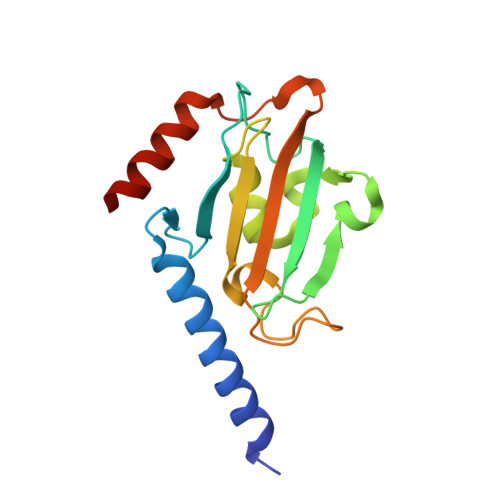Trypanosoma cruzi macrophage infectivity potentiator has a rotamase core and a highly exposed alpha-helix.
Pereira, P.J., Vega, M.C., Gonzalez-Rey, E., Fernandez-Carazo, R., Macedo-Ribeiro, S., Gomis-Ruth, F.X., Gonzalez, A., Coll, M.(2002) EMBO Rep 3: 88-94
- PubMed: 11751578
- DOI: https://doi.org/10.1093/embo-reports/kvf009
- Primary Citation of Related Structures:
1JVW - PubMed Abstract:
The macrophage infectivity potentiator protein from Trypanosoma cruzi (TcMIP) is a major virulence factor secreted by the etiological agent of Chagas' disease. It is functionally involved in host cell invasion. We have determined the three-dimensional crystal structure of TcMIP at 1.7 A resolution. The monomeric protein displays a peptidyl-prolyl cis-trans isomerase (PPIase) core, encompassing the characteristic rotamase hydrophobic active site, thus explaining the strong inhibition of TcMIP by the immunosuppressant FK506 and related drugs. In TcMIP, the twisted beta-sheet of the core is extended by an extra beta-strand, preceded by a long, exposed N-terminal alpha-helix, which might be a target recognition element. An invasion assay shows that the MIP protein from Legionella pneumophila (LpMIP), which has an equivalent N-terminal alpha-helix, can substitute for TcMIP. An additional exposed alpha-helix, this one unique to TcMIP, is located in the C-terminus of the protein. The high-resolution structure reported here opens the possibility for the design of new inhibitory drugs that might be useful for the clinical treatment of American trypanosomiasis.
- Institut de Biología Molecular-CSIC, Jordi Girona 18-26, E-08034 Barcelona and 1Instituto de Parasitología y Biomedicina-CSIC, Ventanilla 11, E-18001 Granada, Spain.
Organizational Affiliation:
















